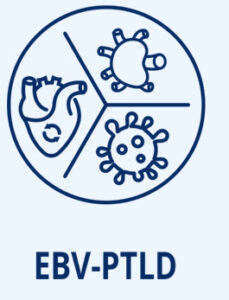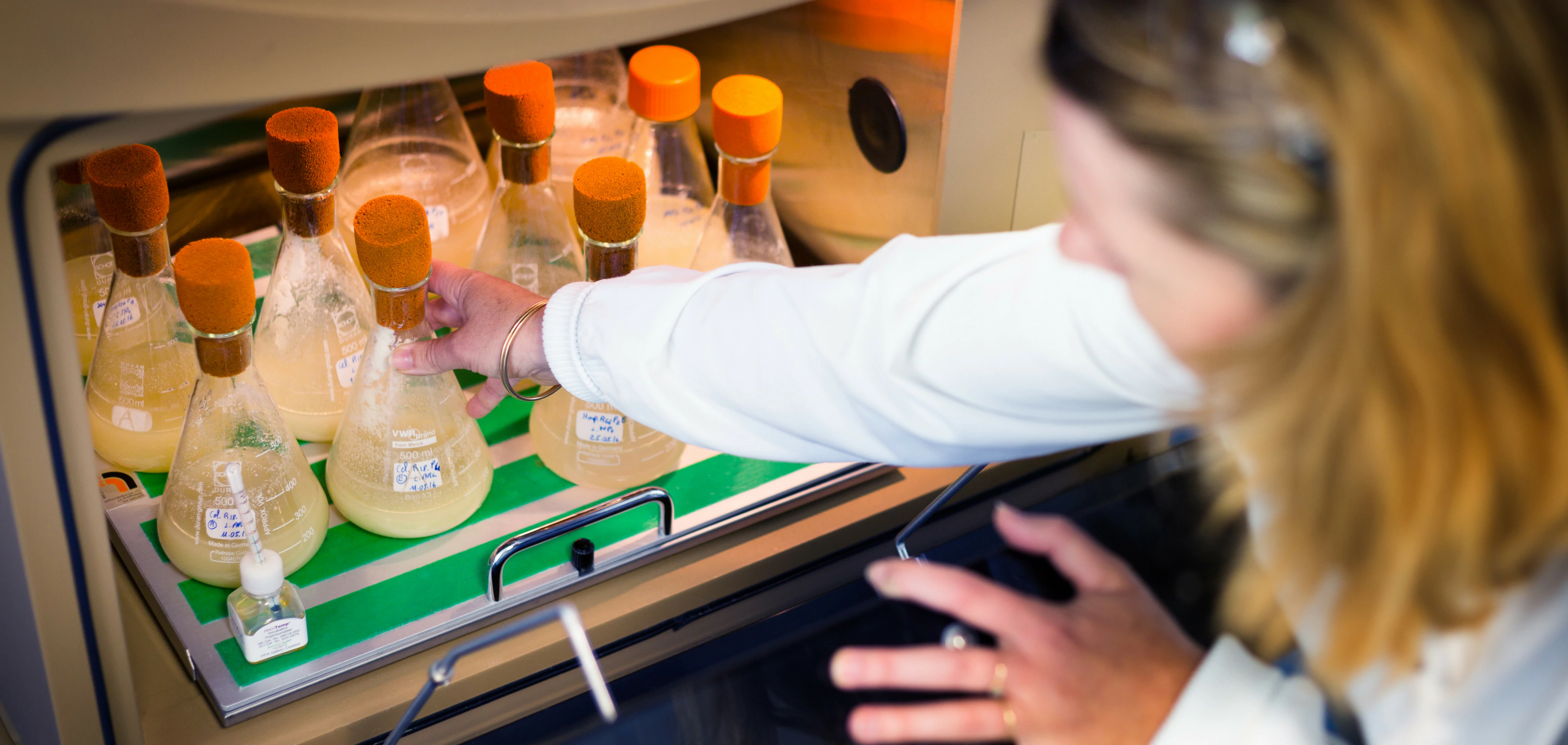
News and updates on EBV-PTLD in 2024
About the indication: Transplantation in humans/patients

Epstein-Barr Virus positive post-transplant lymphoproliferative disease (EBV+ PTLD) is a rare, acute and potentially life-threatening group of lymphoid disorders that arise after transplantation. 1,2

A rare indication: EBV-PTLD

EBV = Epstein-Barr Virus
EBV is member of the herpes family of human viruses5; 90-95% of individuals worldwide have faced an EBV infection, which is normally asymptomatic or causes mononucleosis, and is usually resolved by the immune system developing a T-cell specific anti-viral response.6,7
Despite this, individuals infected with EBV carry the virus for life, with EBV DNA remaining in infected memory B-cells in a so-called latent phase.6,7
When T-cell defence mechanisms are impaired due to immunosuppression or in immunocompromised conditions, viral reactivation or infection can result in the accumulation of EBV-transformed B cells, leading to EBV-driven cancers.7

PTLD in a nutshell.
PTLD = Post-Transplant Lymphoproliferative Disease
PTLD is often associated with the infection of EBV15


Prevalence and risk of PTLD


What causes PTLD?

It all starts with close monitoring And monitoring the most common symptoms.
of post transplant patients.

How is PTLD diagnosed?

Treatment options.

- Dierickx D, et al. Post-Transplantation Lymphoproliferative Disorders in Adults. N Engl J Med. 2018;378:549–562.
- Nijland ML, et al. Epstein-Barr virus-positive posttransplant lymphoproliferative disease after solid organ transplantation: pathogenesis, clinical manifestations, diagnosis, and management. Transplant Direct. 2016;2(1):e48.
- National Service Scotlant. Solid organ transplantation. Available at: https://www.nss.nhs.scot/specialist-healthcare/specialist-services/solid-organ-transplantation/. Accessed April 2023.
- Medscape website. Hematopoietic Stem Cell Transplantation (HSCT): Practice Essentials. Available at: https://emedicine.medscape.com/article/208954-overview. Accessed April 2023.
- Odumade OA, et al. Progress and problems in understanding and managing primary Epstein-Barr virus infections. Clin Microbiol Rev. 2011;24(1):193-209.
- Johns Hopkins ABX guide. Epstein Barr virus. Available at: https://www.hopkinsguides.com/hopkins/view/Johns_Hopkins_ABX_Guide/540208/all/Epstein_Barr_Virus. Accessed April 2023.
- Long HM, et al. The T-cell Response to Epstein-Barr Virus–New Tricks From an Old Dog. Front Immunol. 2019;10:2193.
- EUR-Lex – l21167 – EN – EUR-Lex [Internet]. Europa.eu. [cited 2023 Jul 5] Available from: https://eur-lex.europa.eu/EN/legal-content/summary/medicines-for-rare-diseases-orphan-drugs.html. Accessed: August 2023.
- [Internet]. [cited August 2023]. Available from: https://health.ec.europa.eu/system/files/2023-02/ncd_2022_rare-disease_factsheet_ n.pdf. Accessed: August 2023.
- [Internet]. [cited August 2023]. Available from: https://www.lymphoma.org.au/lymphoma-types/
- [Internet]. [cited August 2023]. Available from: https://lymphomacoalition.org/wp-content/uploads/WLAD-2023-Infographic-Signs-and-Symptoms.pdf
- Engels EA, et al. Spectrum of cancer risk among US solid organ transplant recipients. JAMA [Internet]. 2011;306(17):1891–901. Available from: https://pubmed.ncbi.nlm.nih. gov/22045767. Accessed: August 2023.
- Kinch A, et al. A population-based study of 135 lymphomas after solid organ transplantation: The role of Epstein-Barr virus, hepatitis C and diffuse large B-cell lymphoma subtype in clinical presentation and survival. Acta Oncol [Internet]. 2014;53(5):669–79. Available from: http://dx.doi.org/10.3109/0284186X.2013.844853. Accessed: August 2023.
- Samant H, Vaitla P, Kothadia JP. Post-Transplant Lymphoproliferative Disorders. [Updated 2023 Feb 12]. In: StatPearls [Internet]. Treasure Island (FL): StatPearls Publishing; 2023 Jan-. Available from: https://www.ncbi.nlm.nih.gov/books/NBK513249/. Accessed: August 2023.
- Martinez OM, Krams SM. The immune response to Epstein Barr virus and implications for posttransplant lymphoproliferative disorder. Transplantation [Internet]. 2017;101(9):2009–16. Available from: http://dx.doi.org/10.1097/TP.0000000000001767. Accessed: August 2023.
- Dierickx D and Habermann TM. Post-transplantation lymphoproliferative disorders in adults. New Engl J Med. 2018;378:549-562.
- Starzl TE, et al. Reversibility of lymphomas and lymphoproliferative lesions developing under cyclosporin-steroid therapy. Lancet. 1984;1(8377):583–587.
- Al-Mansour Z, et al. Post-Transplant Lymphoproliferative Disease (PTLD): Risk Factors, Diagnosis, and Current Treatment Strategies. Curr Hematol Malig Rep. 2013;8(3):173–183.
- Dierickx D, et al. Epstein-Barr virus-associated posttransplant lymphoproliferative disorders: new insights in pathogenesis, classification and treatment. Curr Opin Oncol. 2022;34(5):413-421.
- Loren AW, Porter DL, Stadtmauer EA, Tsai DE. Post-transplant lymphoproliferative disorder: a review. Bone Marrow Transplant [Internet]. 2003;31(3):145–55. Available from: http://dx.doi.org/10.1038/sj.bmt.1703806. Accessed: August 2023.
- DeStefano CB, et al. Management of post-transplant lymphoproliferative disorders. Br J Haematol [Internet]. 2018;182(3):330–43. Available from: https://pubmed.ncbi.nlm.nih.gov/29741774. Accessed: August 2023.
- Ligeti K, Müller LP, Müller-Tidow C, Weber T. Risk factors, diagnosis, and management of posttransplant lymphoproliferative disorder: improving patient outcomes with a multidisciplinary treatment approach. Transpl Res Risk Manag [Internet]. 2017;9:1–14. Available from: http://dx.doi.org/10.2147/trrm.s84744. Accessed: August 2023.
- Cockfield SM. Identifying the patient at risk for post-transplant lymphoproliferative disorder. Transpl Infect Dis [Internet]. 2001;3(2):70–8. Available from: https://pubmed.ncbi.nlm.nih.gov/11395972. Accessed: August 2023.
- Nijland ML, Kersten MJ, Pals ST, Bemelman FJ, Ten Berge IJM. Epstein-Barr virus-positive posttransplant lymphoproliferative disease after solid organ transplantation: Pathogenesis, clinical manifestations, diagnosis, and management. Transplant Direct [Internet]. 2016;2(1):e48. Available from: http://dx.doi.org/10.1097/TXD.0000000000000557. Accessed: August 2023.
- Dierickx D, Tousseyn T, Sagaert X, Fieuws S, Wlodarska I, Morscio J, et al. Single-center analysis of biopsy-confirmed posttransplant lymphoproliferative disorder: incidence, clinicopathological characteristics and prognostic factors. Leuk Lymphoma [Internet]. 2013;54(11):2433–40. Available from: http://dx.doi.org/10.3109/10428194.2013.780655. Accessed: August 2023.
- Sampaio MS, Cho YW, Qazi Y, Bunnapradist S, Hutchinson IV, Shah T. Posttransplant malignancies in solid organ adult recipients: an analysis of the U.S. National Transplant Database. Transplantation [Internet]. 2012;94(10):990–8. Available from: http://dx.doi.org/10.1097/TP.0b013e318270bc7b Última consulta: Septiembre 2022. Accessed: August 2023.
- Al-Mansour Z, Nelson BP, Evens AM. Post-transplant lymphoproliferative disease (PTLD): risk factors, diagnosis, and current treatment strategies. Curr Hematol Malig Rep [Internet]. 2013;8(3):173–83. Available from: http://dx.doi.org/10.1007/s11899-013-0162-5. Accessed: August 2023.
- Curtis RE, Travis LB, Rowlings PA, Socié G, Kingma DW, Banks PM, et al. Risk of lymphoproliferative disorders after bone marrow transplantation: a multi-institutional study. Blood. 1999;94(7):2208–16. Accessed: August 2023.
- Styczynski J, Gil L, Tridello G, Ljungman P, Donnelly JP, van der Velden W, et al. Response to rituximab-based therapy and risk factor analysis in Epstein Barr Virus-related lymphoproliferative disorder after hematopoietic stem cell transplant in children and adults: a study from the Infectious Diseases Working Party of the European Group for Blood and Marrow Transplantation. Clin Infect Dis [Internet]. 2013;57(6):794–802. Available from: http://dx.doi.org/10.1093/cid/cit391. Accessed: August 2023.
- Gulley ML, Tang W. Using Epstein-Barr viral load assays to diagnose, monitor, and prevent posttransplant lymphoproliferative disorder. Clin Microbiol Rev [Internet]. 2010;23(2):350–66. Available from: http://dx.doi.org/10.1128/CMR.00006-09. Accessed: August 2023.
- Styczynski J, van der Velden W, Fox CP, Engelhard D, de la Camara R, Cordonnier C, et al. Management of Epstein-Barr Virus infections and post-transplant lymphoproliferative disorders in patients after allogeneic hematopoietic stem cell transplantation: Sixth European Conference on Infections in Leukemia (ECIL-6) guidelines. Haematologica [Internet]. 2016;101(7):803–11. Available from: http://dx.doi.org/10.3324/haematol.2016.144428. Accessed: August 2023.
- Starzl TE, Nalesnik MA, Porter KA, Ho M, Iwatsuki S, Griffith BP, et al. Reversibility of lymphomas and lymphoproliferative lesions developing under cyclosporin-steroid therapy. Lancet [Internet]. 1984;1(8377):583–7. Available from: https://pubmed.ncbi.nlm.nih.gov/6142304. Accessed: August 2023.
- Roschewski M, Wilson WH. EBV-associated lymphomas in adults. Best Pract Res Clin Haematol [Internet]. 2012;25(1):75–89. Available from: https://www.ncbi.nlm.nih.gov/pmc/articles/PMC3305910. Accessed: August 2023.
- Oertel SHK, Verschuuren E, Reinke P, Zeidler K, Papp-Váry M, Babel N, et al. Effect of anti-cd 20 antibody rituximab in patients with post-transplant lymphoproliferative disorder (PTLD). American Journal of Transplantation. 2005;5(12):2901–6. Available from: http://dx.doi.org/10.1111/j.1600-6143.2005.01098.x. Accessed: August 2023.
- Choquet S. Efficacy and safety of Rituximab in B-cell post-transplantation lymphoproliferative disorders: Results of a prospective Multicenter Phase 2 study. Blood. 2006;107(8):3053–7. Available from: http://dx.doi.org/10.1182/blood-2005-01-0377. Accessed: August 2023.
- Choquet S, Oertel S, LeBlond V, Riess H, Varoqueaux N, Dörken B, et al. Rituximab in the management of post-transplantation lymphoproliferative disorder after solid organ transplantation: Proceed with caution. Annals of Hematology. 2007;86(8):599–607. Available from: http://dx.doi.org/10.1007/s00277-007-0298-2. Accessed: August 2023.
The information on this website is due to regional regulations and for pre-informative educational purposes only. Nothing on this website can be copied or used without notifying Pierre Fabre Oncology Benelux.



